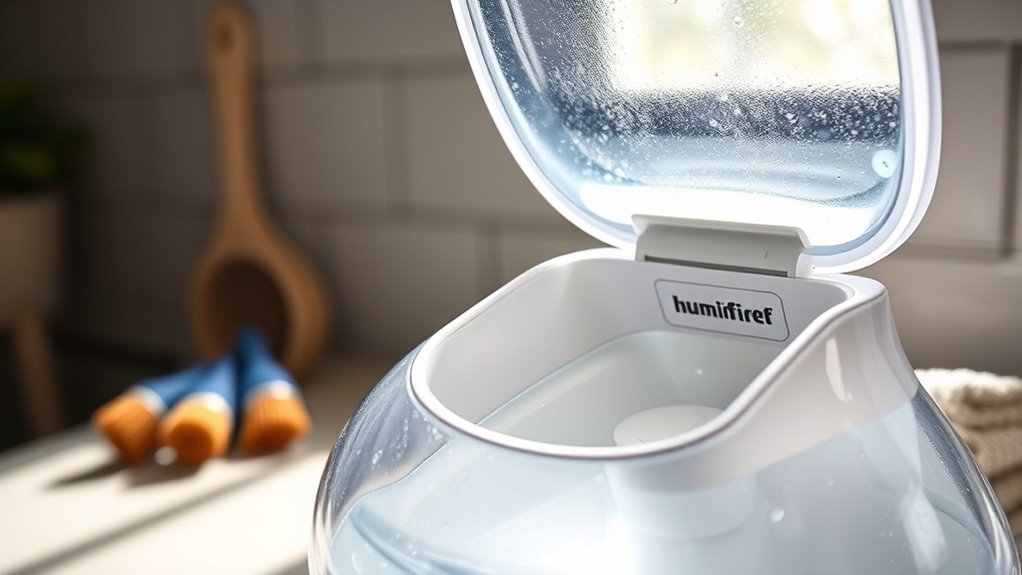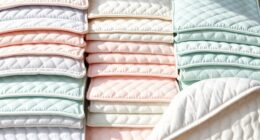To clean your humidifier effectively, start by unplugging it and disassembling all removable parts like the water tank and filter. Use a mixture of white vinegar and water to disinfect and loosen mineral deposits, scrubbing gently with a soft brush. Rinse thoroughly and dry all parts completely before reassembling. Regular maintenance prevents mold and bacteria buildup, ensuring healthier air. Keep going to discover more tips for keeping your humidifier safe and efficient.
Key Takeaways
- Disassemble the humidifier carefully, unplugging it first, and remove all removable parts for cleaning.
- Use a vinegar and water solution to disinfect and remove mineral deposits, scrubbing gently with soft brushes.
- Rinse all parts thoroughly to eliminate vinegar residue and dry completely before reassembling.
- Regularly replace filters and empty the water tank daily to prevent mold and microbial growth.
- Avoid harsh chemicals and essential oils; follow manufacturer guidelines for cleaning frequency and methods.
Why Regular Cleaning Is Essential for Your Humidifier’s Health
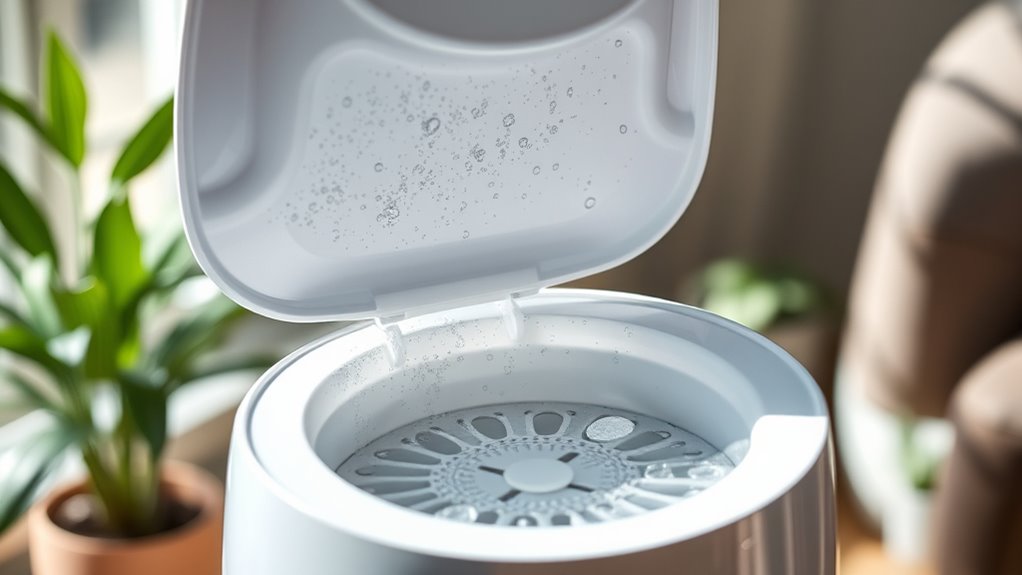
Regularly cleaning your humidifier is essential because it prevents the buildup of mold, bacteria, and mineral deposits that can harm your health. Bacterial buildup inside the device can then be dispersed into the air you breathe, reducing air quality and increasing health risks like allergies or respiratory issues. When you neglect cleaning, these harmful microbes thrive, contaminating the mist you rely on for moisture. Clean units ensure that the air you breathe remains pure and safe. Consistent maintenance also helps your humidifier operate efficiently, saving energy and prolonging its lifespan. By keeping your humidifier free of bacteria and deposits, you support better air quality in your home and protect your health from airborne contaminants. Regular cleaning isn’t just about maintenance—it’s about your wellness.
Step-by-Step Guide to Disassemble Your Humidifier Safely
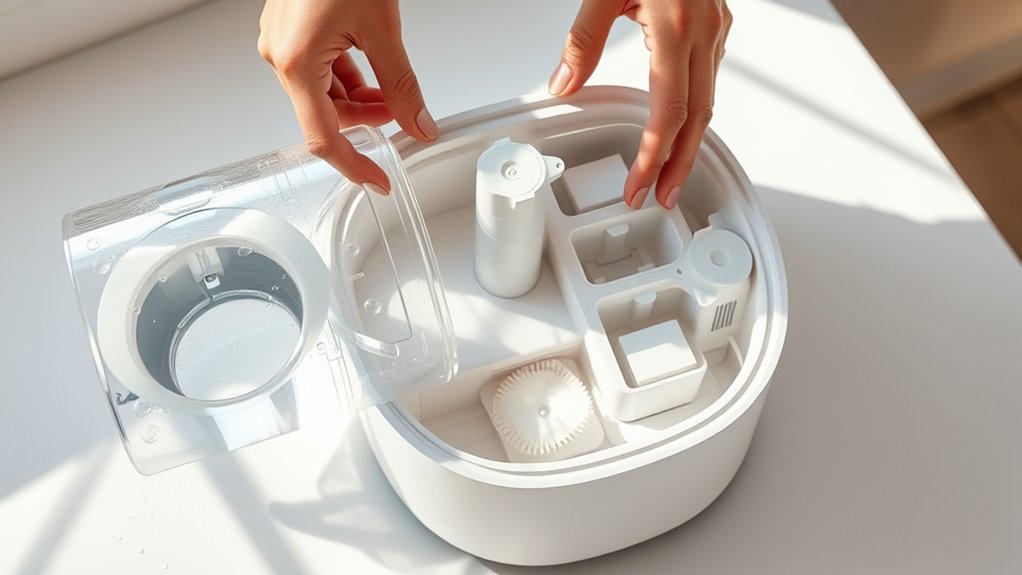
Before you begin disassembling your humidifier, make sure it’s powered off and unplugged. Carefully remove all removable parts, such as the water tank and filter, and keep them separate. Following these steps guarantees your safety and makes cleaning easier.
Power Off & Unplug
To safely disassemble your humidifier, you need to power it off and unplug it first. Prioritizing power safety prevents electrical hazards and protects you from potential shocks during cleaning. Make sure the device is completely turned off, then grasp the plug firmly and remove it from the outlet. Avoid pulling on the cord directly, which can damage the wiring. Unplugging the device ensures no electrical current flows through it, making disassembly safe. Once unplugged, wait a few moments to let any residual power dissipate. This step is essential to prevent accidental activation or electrical issues while you’re handling internal parts. Always handle the humidifier with dry hands and work in a clean, dry area to maintain safety.
Remove & Separate Parts
Once your humidifier is unplugged and powered off, you can begin removing its parts. Carefully detach the water tank, filter, and any removable components. This step is essential for proper cleaning and filter replacement, which helps maintain water quality. Handle each part gently to avoid damage. Use the table below to identify common parts and their functions:
| Part | Purpose |
|---|---|
| Water Tank | Holds water for humidification |
| Filter | Ensures clean, moist air |
| Base | Houses the motor and wick |
| Cover | Protects internal components |
| Nozzle/Outlet | Dispenses mist |
Disassembling correctly guarantees thorough cleaning and prolongs your humidifier’s lifespan.
The Best Cleaning Solutions and Tools for a Spotless Device

Choosing the right cleaning solutions and tools is essential to keep your humidifier operating efficiently and safely. Use a mixture of white vinegar and water to disinfect and break down mineral deposits. For added freshness, avoid using essential oils directly in the tank, as they can damage components, but you can clean with vinegar afterward. If your humidifier uses filters, consider regular filter replacement to prevent mold and bacteria buildup. Soft brushes or cloths are best for scrubbing without scratching surfaces, and a small brush helps clean hard-to-reach areas. Always have clean towels or microfiber cloths ready for drying parts thoroughly. Avoid harsh chemicals that could damage your device or compromise air quality, sticking instead to gentle, effective solutions.
How to Remove Mineral Deposits and Prevent Mold Growth
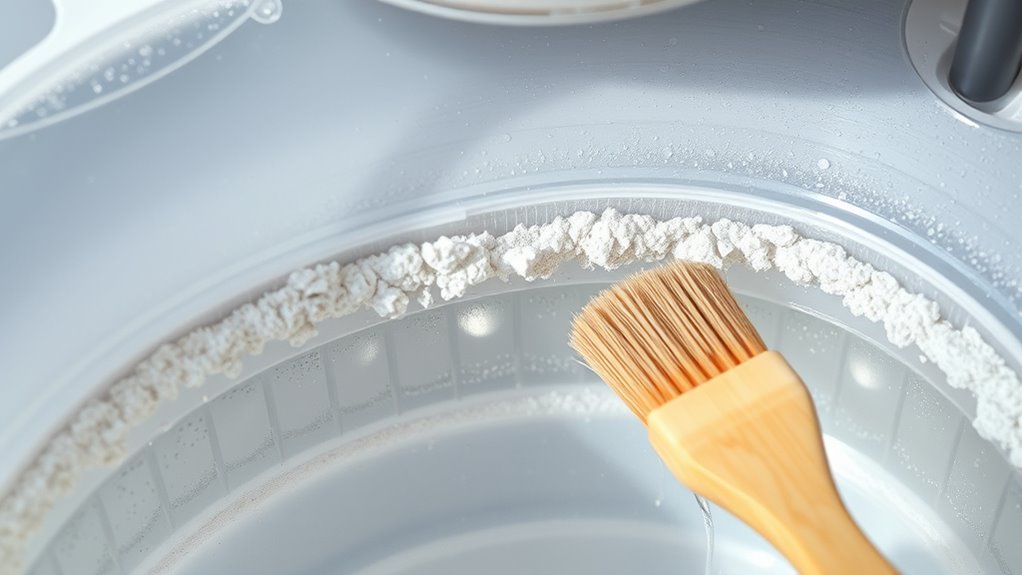
Mineral deposits can quickly build up in your humidifier, reducing its efficiency and potentially spreading impurities into the air. To remove mineral buildup, fill the tank with a mixture of equal parts white vinegar and water, then let it sit for 30 minutes. Scrub away deposits with a soft brush or cloth, paying attention to corners and crevices. Rinse thoroughly with clean water to remove all residue. Regular cleaning helps prevent mold growth by eliminating damp, mineral-rich environments that mold loves. To enhance mold prevention, make sure you dry the humidifier completely after each use and use distilled or demineralized water whenever possible. These steps will keep your humidifier running smoothly and promote healthier indoor air.
Tips for Maintaining Your Humidifier Between Deep Cleans
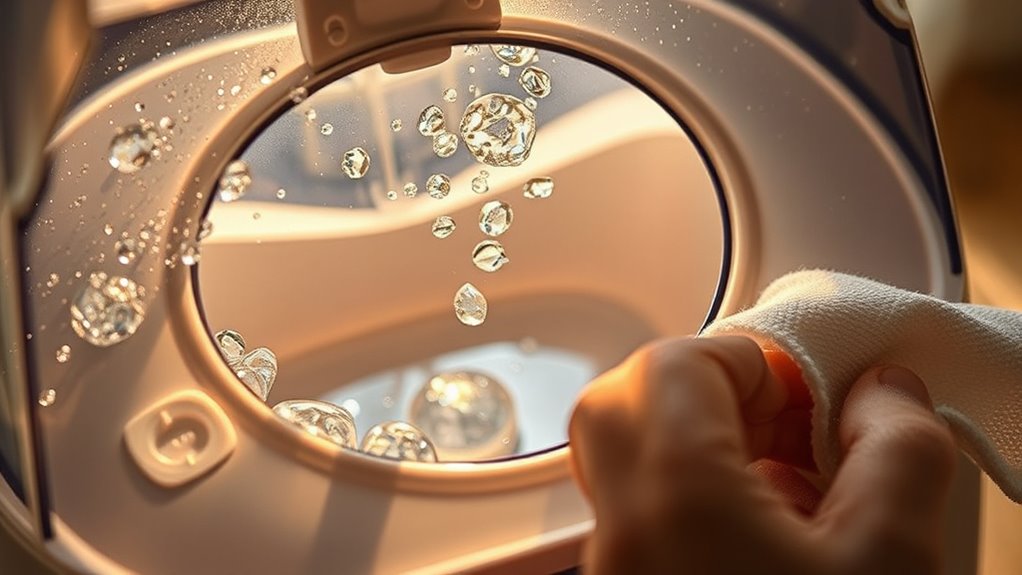
To keep your humidifier running smoothly between deep cleans, it’s important to perform regular maintenance. Start by checking and replacing humidifier filters as recommended by the manufacturer to guarantee optimal performance and air quality. Dirty or clogged filters can reduce efficiency and introduce mold or bacteria. Additionally, periodically test your indoor air quality to catch any issues early; air quality testing helps identify mold spores or airborne contaminants that may develop if the humidifier isn’t properly maintained. Empty the water tank daily, and wipe down all surfaces to prevent mineral buildup and bacterial growth. Using distilled or filtered water can also minimize deposits and improve air quality. These simple steps keep your humidifier functioning well and promote healthier indoor air between deep cleans.
Common Mistakes to Avoid When Cleaning Your Humidifier
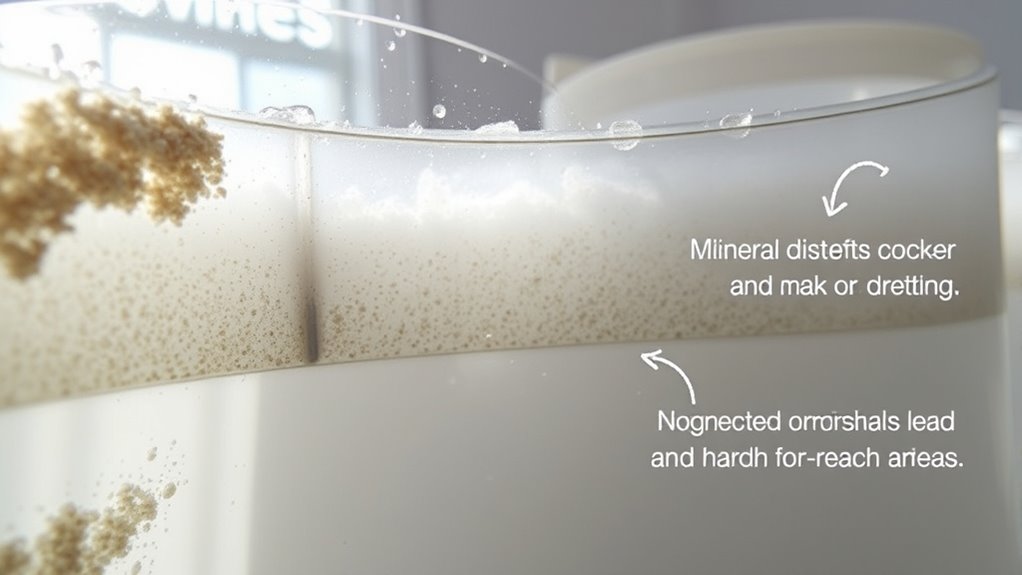
One common mistake is neglecting to clean your humidifier regularly, which allows mold and bacteria to build up. Using harsh cleaning agents can damage the unit or leave harmful residues behind. To keep your humidifier safe and effective, avoid these errors and stick to proper cleaning practices.
Ignoring Regular Cleaning Schedule
Neglecting to follow a regular cleaning schedule is a common mistake that can lead to health issues and reduced humidifier efficiency. When you ignore proper maintenance, humidifier oversight allows mold, bacteria, and mineral buildup to thrive inside the device. This cleaning complacency not only diminishes its ability to add clean moisture but also risks dispersing harmful pathogens into the air you breathe. Skipping routine cleanings creates a breeding ground for germs, which can cause respiratory problems or worsen allergies. To avoid these issues, set a consistent cleaning schedule—preferably weekly—and stick to it. Regular cleaning ensures your humidifier operates effectively, keeps your environment healthy, and prevents the unnecessary health hazards that come with neglecting maintenance.
Using Harsh Cleaning Agents
Using harsh cleaning agents when cleaning your humidifier can do more harm than good. Harsh chemicals and corrosive cleaners may seem effective, but they can damage your device’s delicate parts, leading to corrosion or leaks. These cleaners can also leave harmful residues that get released into the air, posing health risks. Instead, stick to gentle, natural solutions like vinegar or diluted hydrogen peroxide, which are effective at disinfecting without causing damage. Always read your humidifier’s manufacturer instructions to guarantee compatibility with cleaning products. Avoid using bleach, ammonia, or other strong chemicals that aren’t specifically recommended. Using the right, mild cleaning agents helps maintain your humidifier’s longevity and keeps the air you breathe clean and safe.
Frequently Asked Questions
Can I Use Vinegar Every Time I Clean My Humidifier?
You can use vinegar every time you clean your humidifier, but it’s not necessary for every session. For ideal humidifier maintenance, aim to clean it weekly or after a few uses, using vinegar to remove mineral deposits and bacteria. This ensures proper cleaning frequency without overdoing it. Just be sure to rinse thoroughly afterward to prevent any vinegar residue, keeping your humidifier functioning safely and efficiently.
How Often Should I Replace the Humidifier’s Filter or Parts?
You should replace your humidifier’s filter regularly based on the manufacturer’s recommended maintenance schedule, usually every 1 to 3 months. Keep an eye on signs like reduced mist output or odors. For other parts, inspect them monthly and replace as needed to prevent mold and bacteria buildup. Consistent filter replacement and following a maintenance schedule guarantee your humidifier runs efficiently and keeps your air healthy.
Is It Safe to Use Bleach for Cleaning My Humidifier?
Using bleach to clean your humidifier isn’t the safest option due to bleach safety concerns. It can leave harmful residues and irritate your respiratory system. Instead, opt for disinfectant alternatives like white vinegar or hydrogen peroxide, which effectively disinfect without the risks associated with bleach. Always rinse thoroughly after cleaning to make sure no residues remain, keeping your humidifier safe and clean for use.
What Are Signs My Humidifier Needs a Deep Clean?
Did you know that 70% of humidifiers develop mold if not cleaned properly? You’ll notice signs like mold growth or strange odors, indicating it’s time for a deep clean. These issues can spread bacteria and reduce air quality. If your humidifier smells off or shows visible mold, don’t delay — cleaning thoroughly will restore it to safe, healthy operation and keep your home comfortable.
Can Cleaning Products Damage the Humidifier’s Components?
Cleaning products can damage your humidifier if they cause unwanted chemical reactions or aren’t compatible with its materials. To avoid this, always check the manufacturer’s guidelines for recommended cleaners. Using harsh chemicals or incompatible substances may corrode parts or degrade materials, reducing your humidifier’s lifespan. Stick to gentle, approved solutions, and verify thorough rinsing to protect your device’s components and keep it functioning safely.
Conclusion
Think of your humidifier as a garden that needs regular tending. With proper cleaning, it’ll flourish and keep your home fresh. Skipping these steps is like neglecting your plants—you risk mold, mineral buildup, and poor air quality. So, stay diligent and treat your humidifier like a treasured plant. With each clean, you’re watering your home’s comfort and wellness, ensuring it blooms beautifully all season long. Keep it maintained, and enjoy the clean, healthy air you deserve.
